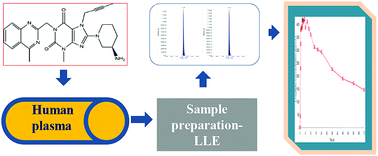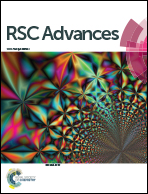An ultra high performance liquid chromatography-tandem mass spectrometry method for the quantification of linagliptin in human plasma
Abstract
A simple, rapid, sensitive, reliable and selective ultra high performance liquid chromatography (UHPLC)-tandem mass spectrometry (MS/MS) method was developed for the quantification of linagliptin (LGN) in human plasma. LGN and its deuterated internal standard (IS) LGN-d4 were extracted from a low-plasma sample (volume: 300 μL) by a simple liquid–liquid extraction protocol. Efficient estimation of the analyte and IS at a mean retention time (RT) of 1.75 and 1.74 min respectively, with a rapid 3.5 min run time per sample was chromatographically established on a Gemini C18 (100 mm × 4.6 mm, 3 μ) column under simple isocratic elution conditions, using a mixture of 10 mM ammonium formate : methanol [20 : 80 (v/v)] delivered at a flow rate of 0.5 mL min−1. Following the separation of the compounds, protonated precursor → product ion transitions were monitored for LGN (m/z: 473.3 → 420.1) and IS (m/z: 477.5 → 424.3) on a triple quadrupole mass spectrometer, operating in a multiple reaction monitoring (MRM) mode. The most recent regulatory guidelines were adopted during the method validation. The method demonstrated very good analyte and IS recovery (not less than 71.0%), precision (≤8.6% CV), accuracy (range: 86.7% to 95.6%) and linearity (r > 0.99) across a clinically relevant LGN plasma concentration range: 50.3 to 12 115.5 pg mL−1. The validated method was successfully applied to pharmacokinetic study samples for measuring linagliptin plasma levels.


 Please wait while we load your content...
Please wait while we load your content...